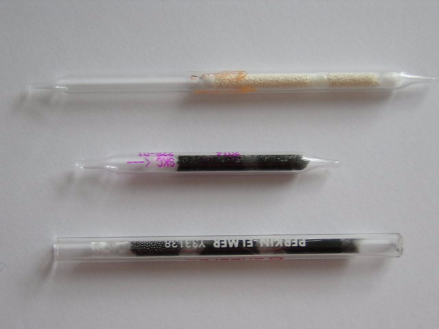Outdoor air quality
OUTDOOR AIR. GAS PHASE AND PARTICULATE PHASE CONTROLS
IDENTIFICATION AND QUANTIFICATION OF VOLATILE ORGANIC COMPOUNDS. METHODOLOGIES
The sampling and analytical methodologies developed for chemical control have been focused in volatile organic compounds (VOC), mainly due to their significant contribution to total pollutants emissions, their low level of control and their importance in public health, as several VOC families are potentially toxic to humans (organochlorine compounds, aromatic hydrocarbons, polycyclic aromatic hydrocarbons, …). VOC emission data is rarely known due to their low degree of control; hence, an analytical methodology able to evaluate a wide range of these compounds was needed. The analytical method developed and validated in our laboratory (Ribes et al., 2007) is based in dynamic sampling of VOC in a multi-sorbent bed tube and its posterior analysis through thermal desorption coupled to gas chromatography/mass spectrometry (TD-GC/MS). Additionally, a dynamic sampling device for the evaluation of odorous episodes and air quality has also been developed in our laboratory (Roca et al., 2006), taking into account a series of quality control recommendations (inert material, 10 calibration flow levels, high flow stability, sequences programming and remote activation through radio frequency or mobile phone).
The applications of the above mentioned methodology in real scenarios have been the following:
> Sampling of odorous episodes through social control (activation and deactivation of the samplers by the affected people or by technicians or municipal police) in established points or in mobile sources (vehicles)
> Evaluation of immission levels in urban areas. Generation of concentration and odour maps
> Sampling of odorous episodes and determination of air quality indoors (evaluation of deficiencies in ventilation systems design, evaluation of impacts from external sources in sick building syndrome situations, …)
> Evaluation of VOC reduction efficiencies in systems designed for indoor air quality enhancement
References:
- Ribes, A., Carrera, G., Roca, F.J., Berenguer, M.J., Guardino, X., “Development and validation of a method for air quality and nuisance odors monitoring of volatile organic compounds using multisorbent adsorption and GC/MS thermal desorption system”, Journal of Chromatography A, 1140, pp. 44-55 (2007)
- Roca, F.J., Corruchaga, A., Folch, J., “Captador dinámico de olores y compuestos tóxicos en aire con activación remota”, ES 2 311 396 B1, Oficina Española de Patentes y Marcas, Madrid (2006)
- Gallego, E., Roca, F.J., Guardino, X., Rosell, M.G., Gadea, E., “Calidad del aire interior: compuestos orgánicos volátiles, olores y confort”, NTP 972, Instituto Nacional de Seguridad e Higiene en el Trabajo (INSHT), NIPO : 272-13-036-3
 |
 Sorbent tubes |
 Dynamic sampler |
 Thermal desorption – GC/MS |
 |
 Figure 1. TIC chromatogram of an urban air sample: identification and quantification of VOC |
CONCENTRATION MAPS
Concentration maps of individual compounds or VOC families can be generated with the chemical control obtained data. The distribution of the different evaluated compounds in the studied area provides a first approach of the possible sources of VOC, as can be observed in figure 2.
 Figure 2. Individual compounds maps |
 Familial map: Organochlorine compounds |
CHARACTERIZATION OF THE PARTICULATE PHASE
LCMA offers the characterization of PM10 and PM2,5 particulate phases, suspended particulate matter and setting dust, as well as the identification and quantification of polycyclic aromatic hydrocarbons (PAH).
|
Table 1. Polycyclic aromatic hydrocarbons concentration levels in PM10 particulate phase



Share: